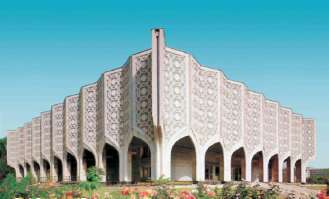 15 years ago, during the challenging time when statehood, government, and civil society institutions were being developed and the country became a transition economy, the government made a decision most important for the future of the nation’s artistic culture. Creating enabling environment for the national art to integrate into global cultural space as a unique phenomenon has been set as one of priorities in independent Uzbekistan. The Academy of Arts of Uzbekistan (AAU) established on the 23rd of January, 1997 by the Decree of the President of Uzbekistan Islam Karimov has been called upon to realize this objective.
15 years ago, during the challenging time when statehood, government, and civil society institutions were being developed and the country became a transition economy, the government made a decision most important for the future of the nation’s artistic culture. Creating enabling environment for the national art to integrate into global cultural space as a unique phenomenon has been set as one of priorities in independent Uzbekistan. The Academy of Arts of Uzbekistan (AAU) established on the 23rd of January, 1997 by the Decree of the President of Uzbekistan Islam Karimov has been called upon to realize this objective.
The establishment of the Academy has set a foundation for the revival and development of unique traditions in the country’s fine and applied arts, and for providing support to creative processes in Uzbekistan’s art by way of promoting art education, exhibition activities, research, art criticism and enlightenment. Today, the Academy of Arts and all its member institutions facilitate the development of artistic culture and aesthetic education, asserting fundamental human values and promoting national interests in this domain.
 SJ: Akmal Vahobjanovich, first of all, let me congratulate you on your appointment as Chair of the Academy of Arts of Uzbekistan, which marks its 15th anniversary this year. At this milestone one can take stock of achievements and identify prospects. What can you say about the Academy of Arts as its new leader?
SJ: Akmal Vahobjanovich, first of all, let me congratulate you on your appointment as Chair of the Academy of Arts of Uzbekistan, which marks its 15th anniversary this year. At this milestone one can take stock of achievements and identify prospects. What can you say about the Academy of Arts as its new leader?
AN: Thank you for your congratulations. The Academy of Arts is a unique institution that could only be established in an independent country. The main objective of the Academy is to enable the national art to enter global cultural space as a unique artistic phenomenon. At present, this objective is still relevant. It’s another matter that today we can already take stock of what has been done by the Academy, make note of both its successful initiatives, and areas that still require to be worked on, with results yet to be seen. However, looking at the progress made over the 15 years, one can definitely say that the Academy of Arts has been able to find its niche in the cultural life of independent Uzbekistan.
SJ: What areas in the Academy activities would you describe as priorities?
AN: The main directions in the Academy’s work have already been identified. They are: art education, exhibition activities, research, and promotion. The task at hand, taking into account what has already been accomplished or still needs to be done – is to focus on areas such as art education that has to be brought to a higher quality standard corresponding to the overall global development trends; to strengthen international links with art schools in other countries; to develop textbooks and electronic libraries on art-related topics. After all, what is the system of art education? It is a domain where the future of the national art is being shaped. Priorities as defined in the art education system will determine the future of our art.
We must realize that not only do we teach our students by giving them professional skills; we shape a new generation of young people who should be able to take pride in their country, speak several languages, and know how to navigate in contemporary information environment. All this should be addressed in the national art education concept.
SJ: What could you say about exhibition activities of the Academy?
AN: This is one of the core areas of the Academy’s work, the important elements of which include demonstrating achievements of domestic and foreign art to people in Uzbekistan, and presenting Uzbek national art overseas, for not only does it carry a part of spirit and mentality of Uzbek people, but also demonstrates success of our country in the global arena. By exhibiting Uzbek art abroad we declare ourselves as independent, democratic and secular nation with rich historical and cultural heritage and contemporary art worthy of this heritage. The territory of Uzbekistan has always been a crossroads where different peoples, confessions and cultural traditions met, leaving a kind of a “genetic code” in our people’s mentality. This provides a good basis for the development of arts in Uzbekistan. Over the years of independence, through the government policy in cultural domain, the artist’s social status has been raised, encouraging people of artistic profession to create works of art worthy of our great ancestors’ creations – works that reflect the present and look into the future.
Another still relevant and important area is to introduce people to culture and art. It requires an approach that balances cultural activity in the center and on the periphery. We must not forget that our exhibitions should reach out to people in the provinces. Art schools in the regions must become real cultural and artistic hubs, hosting exhibitions, discussions and presentations. There is still a lot to be done in this area. Regularly held international projects, such as Tashkent International Contemporary Art Biennale and Photo-Biennale contribute substantially to making Tashkent an international cultural centre. We have to be thinking about launching new projects and organizing international symposia to further strengthen connections between countries and help develop different art forms, which would inspire local artists to engage in creative pursuits and inquiry.
SJ: What is the role of young people in exhibitions run by the Academy?
AN: In recent years young artists actively participate in exhibitions. There is a good environment for them to work productively, exhibit their art in beautiful halls, and take part in different large-scale projects, such as those run by the “Forum” Foundation, as well as in “Yangi avlod”, “Kelajak ovozi” and “Navkiron Uzbekiston” festivals aimed at finding and supporting creative and talented youth; no other country runs events like these. Being member of a jury panel in these festivals for many years, I can say that we do have talented young people, and we need to support them. And they, in turn, must be determined to develop their capacity and broaden their knowledge, work hard and learn to be successful. After all, not only talent is important in art, but also a systematic day-to-day work. Only the synergy of these components can bring good results.
SJ: What can you say about the research work at the Academy?
AN: In the field of research we still have much to do. First, improve the standard of academic research among professors and teaching staff of the Behzad National Institute of Arts and Design. Second, serious academic research on history and contemporary art of Uzbekistan has to be done at the International Caravanserai of Culture, the Memorial Garden-Museum of Behzad, and in the Artist’s Union – all mandated to explore academic and theoretical aspects of different artistic phenomena. Besides, more extensively promote the unique art and culture of our country by publishing catalogues, booklets and brochures about artists, exhibition projects, conferences, seminars, and symposiums, to exchange views and share success stories.
SJ: A somewhat personal question, if you allow: would it not be a challenge for you to combine managerial duties and painter’s artistic work?
AN: Until now, my art was all to me. Yet, in everyone’s life there may come a turning point, when one’s habitual lifestyle changes. Remember the saying of Confucius, “The world is changing every minute, every second, and one must be able to fit into the changing world”? My appointment as Chairman of the Academy of Arts of Uzbekistan shows that the government considers me fit to be entrusted with this huge responsibility, I will do my best to justify this trust! And I shall never cease to be a painter.
SJ: What would you like to say to the artists of Uzbekistan?
AN: Be healthy, wealthy, hardworking, and, most importantly, successful, for the benefit of our independent land of Uzbekistan!
